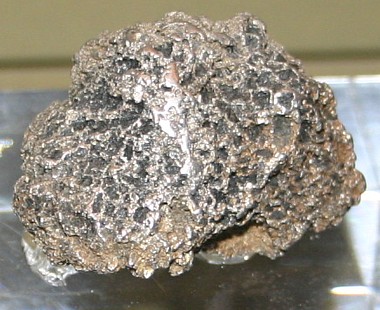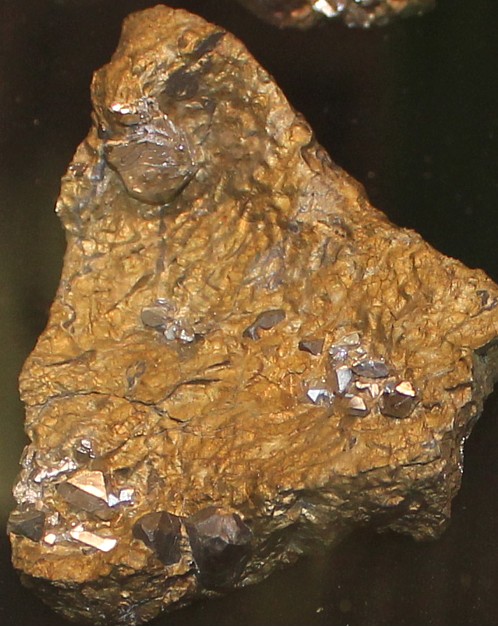Platinum is a very rare metal, occurring only in trace concentrations in the Earth's crust. Platinum occurs as the native metal, although that form now constitutes only a small source of the metal. It is a grayish white, lustrous metal, having a specific gravity of 21.46, and melting at 1,760 C. It is malleable and ductile, and may be welded at a bright red heat. The uses of platinum chiefly depend upon its high fusing point (1700 to 1800 C.) and its resistance to chemical reagents. It is valuable for all sorts of laboratory apparatus, such as crucibles, dishes, spoons, etc. It is used in the sulfuric acid industry for concentrating kettles and also in the contact process for the manufacture of the acid in the form of finely divided platinum, in contact with which the acid is formed. It is also largely used as a catalytic agent in the manufacture of Nitrogen oxides from ammonia resulting in the formation of man made nitrates. Platinum and palladium are also used in automobile catalytic converters that reduce air pollution. It is used in jewelry, particularly as the setting for diamonds, in dentistry in the making of false teeth, in electrical heating apparatus, for sparking plugs in explosion motors, in the measuring of high temperatures, in electrical contacts, etc. Potassium chloroplatinate, is sometimes employed in photography. Platinum is refined and separated from the associated platinum group metals by a somewhat complicated series of operations involving fractional crystallization or resin capture.
Most platinum is recovered from primary hard rock deposits, and these are of the greatest economic importance. Platinum is nearly always found in basic igneous rocks, such as peridotite and dunites, and in serpentine derived by alteration of such rocks. By disintegration of these rocks and concentration in stream gravels, platinum accumulates in placers. Platinum generally contains small amounts of palladium and other metals of the platinum group iridium, osmium, palladium, rhodium, and ruthenium. These metals are closely associated in nature, almost invariably as native alloys. The most important mineral of the platinum group is sperrylite (PtAs2). Sperrylite is a rare arsenide mineral, which has been found very sparingly in a limited number of localities in association with copper ore and nickel ores. In the nickel deposits at Sudbury, Ontario, sperrylite, accompanied by palladium arsenide, forms small silvery-white cubes which are intergrown with pyrrhotite and chalcopyrite.
The modes of occurrence of platinum are as follows: 1) In placers; 2) Disseminated in weakly segregated deposits of peridotite and olivine gabbro, associated with chromite; 3) In stratified magmatic segregation deposits in basic rocks, associated with chalcopyrite and pyrrhotite (with palladium); 4) In small quantities in a very few quartz veins; 5) In contact metamorphic deposits; 6) In traces in porphyry copper deposits of many kinds (with palladium); 7) Concentrated by processes of oxidation in replacement ores of copper and gold in limestone (with palladium). Platinum and palladium ore deposits are rare, and the most extensive deposits have been found in just a few deposits. These include the norite belt of the Bushveld Igneous Complex covering the Transvaal Basin in South Africa, the Stillwater Complex in Montana, United States, the Thunder Bay District of Ontario, Canada, and the Norilsk Complex in Russia.
A century ago, most of the world's output of platinum was obtained from alluvial deposits in the Ural district of Russia. The native platinum in the placers forms small rounded, also concretionary and knobby dark-gray pieces. Bright silvery scales of iridosmine occur with it. In the Ural large pieces of platinum have been found, the largest weighing about 26 pounds. The amounts of placer platinum contributed by Colombia, New South Wales, the United States, and Canada have been comparatively small. In the alluvial deposits of the Urals, platinum is sometimes found associated with gold, and sometimes without gold. It is noteworthy that platinum is an original mineral formed in some peridotites; and in the Urals, where no gold occurs in the platinum-bearing gravels, these gravels can be seen to have been derived from peridotite or serpentine and the associated basic rocks. Where gold occurs, this has been derived from different deposits in quartz veins. The platinum is associated also with chromite, another mineral which occurs frequently in peridotite and serpentine.
Other minerals found associated with platinum in alluvial deposits are iridium and osmiridium. The Ural placer deposits contain on the average about 5 dwt. of platinum per ton, but occasionally much richer deposits are found. The most -productive of the Ural placers are those occurring along the Iss and Pura rivers, and these are said to yield about 80 per cent, of the Russian output. In western Colombia, South America, platinum-bearing gravels occur chiefly in the Choco district ; and platinum is also found to a small extent in the gold-bearing gravels of the Barbacoas district farther south. Platinum is found in gravels at Fifield, in New South Wales; in the gold-bearing gravels and beach-sands of California and Oregon in the United States; in the placers of Goodnews Bay at Seward peninsula, Alaska; and in those of the Tulameen and Similkameen rivers in British Columbia. Palladium occasionally occurs alloyed with gold. In Brazil, such palladium gold in a limestone close to the contact of an igneous rock.
In Canada, platinum and palladium are obtained from the mattes obtained by smelting the nickel-copper ore of Sudbury, in Ontario. The high-grade mattes contain from 0.2 to 0.5 oz. of platinum metals per ton. The platinum occurs in the Sudbury copper-nickel ore as sperrylite, embedded in chalcopyrite. Platinum-bearing nickeliferous pyrrhotites are known to occur elsewhere, as in the Bushveld complex of the Insizwa Range of Cape Province in South Africa. Considerable amounts of platinum are obtained from the Sudbury mattes, but the Bushveld deposits yield an even greater amount. Palladium can be found as a free metal alloyed with gold and other platinum-group metals in placer deposits of the Ural Mountains, Australia, Ethiopia, North and South America. Platinum is reported to occur in the highlands of Honda, Malaga province, Spain, where there is an abundant development of serpentinized peridotites. The platinum is associated with chromite, and is concentrated in the basal layer of the surface gravels. Platinum is associated with gold and osmiridium in the island of Borneo.
In the US, sperrylite, the same mineral found in the superficial zone of some of the Sudbury mines, has also been mined in the Rambler mine in Wyoming where it occurs in copper ores, mainly chalcopyrite and covellite. Here it is probably of igneous origin and forms a lens in a dioritic rock. Much palladium is also present in the Rambler mine. Platinum and palladium are found with gold in ores of the Boss mine, in the Yellow Pine district, Clark County, near Moapa, in eastern Nevada. The ore minerals here are associated with quartz that replaces dolomite along vertical fractures. Granite porphyry intrudes the dolomite, and no basic igneous intrusive rocks are known in this region. The ore is oxidized and contains a bismuth-bearing variety of plumbojarosite. All metals at the Boss Mine are found in minute division. The gold is rough, black and spongy, the palladium-platinum appears as microscopic black grains. The platinum metals were probably contained in the primary sulphides and most likely have been concentrated by solutions in which they were present in colloid suspension. Neither the Rambler nor the Boss mines have been important sources of platinum. At many copper mines across the western US, platinum and palladium are recovered in the electrolytic refining of copper bullion by processing the mud that forms in vats where blister copper is purified. The most important source of platinum group metals in the US has been at Goodnews Bay in Alaska. These placer deposits produced about 545,000 troy ounces by dredging between 1927 and 1975.
Return
to Metal Ores Page:
Precious and Base Metal Ores

Native Platinum nugget, Ural Mountains, Russia

Sperrylite (silver colored crystals) from Norlisk, Russia
